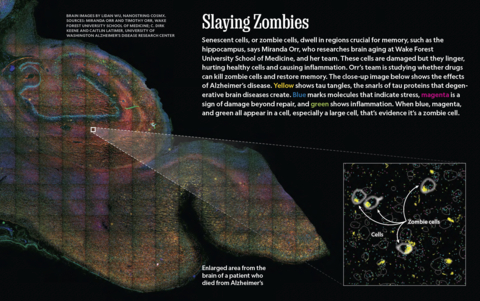National Geographic Magazine Showcases NanoString’s Spatial Biology Technology to Examine Cell Death in Alzheimer’s Disease
NanoString Technologies, Inc. (OTC: NSTGQ), a leading provider of life science tools for discovery and translational research, today announced that research using the company’s CosMx™ Spatial Molecular Imager (SMI) has been featured for a third time in National Geographic Magazine.
This press release features multimedia. View the full release here: https://www.businesswire.com/news/home/20240327487526/en/

Senescent cells, or zombie cells, dwell in regions crucial for memory, such as the hippocampus, says Miranda Orr, who researches brain aging at Wake Forest University School of Medicine, and her team. These cells are damaged but they linger, hurting healthy cells and causing inflammation. Orr's team is studying whether drugs can kill zombie cells and restore memory. The close-up image below shows the effects of Alzheimer's disease. Yellow shows tau tangles, the snarls of tau proteins that degenerative brain diseases create. Blue marks molecules that indicate stress, magenta is a sign of damage beyond repair, and green shows inflammation. When blue, magenta, and green all appear in a cell, especially a large cell, that's evidence it is a zombie cell. (Graphic: NanoString)
A special-interest magazine from National Geographic called Anti-Inflammation, available on newsstands this week, spotlights the role of inflammation on health and disease. The article, “How to Slow Down the March of Time,” features research on senescent “zombie” cells from the lab of Dr. Miranda Orr, associate professor of Gerontology and Geriatric Medicine at Wake Forest University School of Medicine and a research scientist at the W.G. Hefner VA Medical Center in Salisbury, NC.
“Our work focuses on understanding how and why the risk of neurodegenerative diseases increases with advanced age. We discovered that senescent cells, which accumulate with aging, contribute to brain diseases including Alzheimer’s. In clinical trials, we are examining potential therapeutic interventions that clear these toxic cells in patients with Alzheimer’s disease. The visualizations and data achieved with the CosMx SMI instrument provide unprecedented subcellular information across brain regions impacted by Alzheimer’s disease. The technology allows us to characterize these cells and search for new therapeutic targets to clear them, a vital aspect of our progress,” said Dr. Orr.
Senescent cells are those cells that have stopped dividing but remain active and can release substances believed to cause inflammation and damage to nearby healthy cells. Previous research by Orr’s lab identified that the brains of people with Alzheimer’s disease have more senescent cells than healthy people.
“Imagery is an integral part of storytelling at National Geographic. By using these amazing images to help explain the science behind inflammation, we hope to generate more awareness of the promising research on how inflammation affects brain health, a major global health concern,” said Lori Cuthbert, senior editor at National Geographic Magazine.
“It’s tremendously motivating to all of us at NanoString to see CosMx SMI images contribute to the public’s understanding of inflammation and its role in disease. Few publications offer the expansive access to science that National Geographic offers its readers, and we are pleased to see this groundbreaking research with CosMx SMI highlighted in the magazine,” added Brad Gray, President and CEO of NanoString.
About NanoString
NanoString Technologies, a leader in spatial biology, offers an ecosystem of innovative discovery and translational research solutions, empowering our customers to map the universe of biology. The GeoMx® Digital Spatial Profiler is a flexible and consistent solution combining the power of whole tissue imaging with gene expression and protein data for spatial whole transcriptomics and proteomics. The CosMx™ Spatial Molecular Imager is a single-cell imaging platform powered by spatial multiomics enabling researchers to map single cells in their native environments to extract deep biological insights and novel discoveries from one experiment. The AtoMx™ Spatial Informatics Platform is a cloud-based informatics solution with advanced analytics and global collaboration capabilities, enabling powerful spatial biology insights anytime, anywhere. At the foundation of our research tools is our nCounter® Analysis System, which offers a secure way to easily profile the expression of hundreds of genes, proteins, miRNAs, or copy number variations, simultaneously with high sensitivity and precision.
For more information, visit www.nanostring.com.
NanoString, NanoString Technologies, the NanoString logo, CosMx, GeoMx, AtoMx, and nCounter are trademarks or registered trademarks of NanoString Technologies, Inc. in various jurisdictions.
This news release may include information regarding CosMx™ SMI products for RNA detection, products that are not available in the Federal Republic of Germany. Such limitations are further described here.
View source version on businesswire.com: https://www.businesswire.com/news/home/20240327487526/en/
Contacts
Meg O’Conor
Director, Public Relations
moconor@nanostring.com
Phone: 206-602-1768
More News
View More



Recent Quotes
View More
Quotes delayed at least 20 minutes.
By accessing this page, you agree to the Privacy Policy and Terms Of Service.